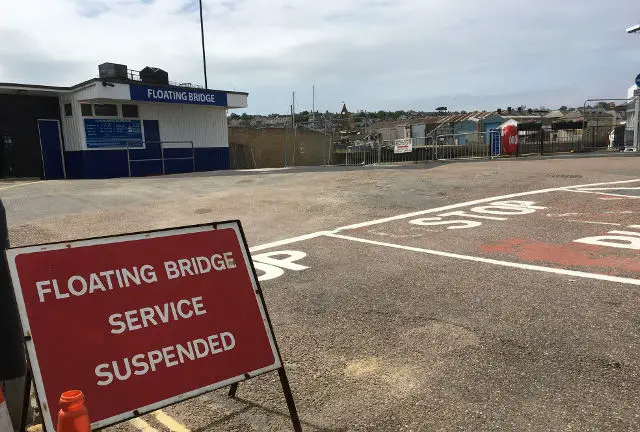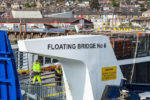Following the announcement of the ‘trial’ return of the Cowes floating bridge, some of the stakeholders in East Cowes have shared this response. Ed
There are a lot of problems with this floating bridge that make it not fit for purpose and will make it very infrequent and at times unreliable. Infrequent and unreliable will mean people will not use it, and we will have 30 years of increasing traffic in Newport and kill East Cowes in the process.
Properly fixing the floating bridge would require major engineering works, including cutting the bridge in half and taking out a ten-foot section and building another pedestrian hold amongst other things.
Do not accept this floating bridge
The Council shouldn’t even be doing trials with this floating bridge because it clearly does not meet the requirements set out in the Invitation to Tender, Scope of Requirements, and the Solent Local Enterprise Partnership’s business case (the funder).
Doing a trial under the best of conditions can lead to ‘confirmation bias’ – getting the results that you want to get even though it’s not the true results.
Other issues
It’s not just the prows, noise and chains, and the Statement of Requirements requires more. Amongst many other things, the shape of the hull is too boxy and is more likely to ground on the slipway which we have witnessed many times.
The bridge is tall and acts like a sail, making crossings slower. This bridge is almost 60% heavier, and it struggles during strong tides.
The length of the bridge is no secret problem, as almost every Islander who knows the tides and that stretch of water seeing the new bridge in the flesh has said ‘that bridge is way too big!’. This is particularly an issue at low tide, jutting out further than the old bridge as a large river obstacle.
Passenger accommodation not ‘improved’
The ‘double decker’ pedestrian hold takes much longer to unload.
In addition, we’ve lost 50% of our sheltered space and a lot of disabled access despite a requirement to ‘improved passenger accommodation’.
Issues for driver
The single central wheelhouse (driver’s cabin) means that not only does the driver have more difficulty judging the bridge’s position to the slipway, but also the driver’s seat is far away – two levels up and in the centre – making it difficult for that staff member to descend quickly to be useful by opening the gate or collecting tickets.
This may mean hiring at least one extra staff member position at a cost of around £1 million over 30 years, if not more. And each staff position is more than one person because the bridge operates 17 hours a day all year.
Noise issues
The noise is a huge problem, at levels much louder than the old floating bridge and above World Health Organisation limits.
The tall hinge of the prow makes an echo chamber under the prow when cars drive on and off of it at certain tides, as well as other noise issues.
Must meet Statement of Requirements
This floating bridge has to meet its Statement of Requirements – those mandatory promises like ‘increased crossings per day’ and ‘improved passenger accommodation’ – and it cannot meet these without somewhere between £1 million – £2 million in huge alterations (not including design costs or overrun contingency funding).
If this bridge is not frequent, reliable, safe, operating without interruption 17 hours a day, 365 days a year, business customers won’t use it, cars will drive around, and it will no longer make the Council the hefty profit it always made….in fact it could cost the Council money.
Lack of consultation
There is a point where the Council needs to make difficult decisions, and we are there. It’s clear that not enough of the problems have been fixed or can be fixed.
Stakeholders have never been consulted properly, and the Council risks going forward with bad decision-making once again without consulting with stakeholders such as the shops, Newport, etc.
Buy a new bridge
The best decision for the Council now is to throw this bridge to legal consideration; get a low-interest loan for a new floating bridge and start the procurement process with a design more similar in size to Floating Bridge 5; buy and run a stable, disabled access Jenny boat; and pay back the loan with the sale of floating bridge 6 and/or legal winnings and with future profits of the new, functional, frequent and reliable floating bridge.
There will still be some profit in the later years to come to the Council.
The risks of accepting this floating bridge are huge; doing any trials right now lead to ‘confirmation bias’ (creating the best circumstances to make it look like it can work always in all situations).
Problems down the line
What would the Council do if a new bridge goes from making them £100,000s of profit to costing them money, all because of THAT bridge? Will they keep the floating bridge ‘service’ or say that they can no longer afford it, and we lose the floating bridge?
Or, when realising it’s not profitable, will it cost the Council even more money to try to buy a new floating bridge in a year or two, and sell a then-used floating bridge – deprecated in value – and also risk that the Council might not be able to secure a low-interest loan in the future to procure a new one?
Officers are not engineers
The politicians were not involved in the actual design and procurement of this floating bridge; the staff (‘officers’) were. But even those officers are not engineers. This is an easy decision when one does the risk assessment.
Some of the problems can be fixed, but not enough of them to make it work properly. Accepting a faulty floating bridge also does not protect the Council from potential damage claims and/or lawsuits.
A faulty or difficult-to-operate bridge will only get worse with time. This is about 30 years, debilitating traffic and three major Island economies, not about this year’s budget.
Don’t accept this floating bridge. The best decision is to get a new one sorted now.
Some of the possible, potential problems:
• Hull is too ‘boxy’ (grounds more easily) Reliability
• Too long (grounding, room for yachts) Frequency, Reliability, Health and Safety
• Too wide (landing problems, tide issues, accidentally hitting pedestrian railings) Frequency,
Reliability, Health and Safety
• Too tall (wind resistance) Frequency
• Too heavy (60% heavier – tides pulling) Frequency
• Chains too light (‘floating up’ with bridge, hitting yachts) Frequency, Health and Safety
• Length of chains – longer & shorter issues Frequency, Health and Safety
• Slipway angle (not congruent with prows) Frequency, Reliability
• Slipway too narrow (& will silt in E Cowes) Frequency, Reliability, Health and Safety
• Noisier & causes vibration – cottages (hydraulics, & ramp shakes cottages) nothing can be done to
the slipway or the prow to dampen that noise (it has been tried before with the old bridge). The prow is too high and creates an amplifying space underneath it. All dampening material gets destroyed quickly by the bridge; the last time it was tried, it only lasted a day literally. The bridge is quite strong, and this one is bigger and 60% heavier. Health and Safety
• Only one ground-level pedestrian cabin Frequency
• Plastic bearings (wear out) Reliability, Cost
• Bearings on outside of supports (access) Reliability, Cost
• Soft wheels (replacement costs, staff time) Reliability, Cost
• Unsafe mandatory queuing on pavements – north pavement in East Cowes – unless you let
pedestrians stand where they wish in East Cowes like they used to, and to exit separate from the cars (whichever way they see fit), the floating bridge will have problems. Frequency, Health and Safety
• Upstairs pedestrian area (unsafe, wet) Frequency, Health and Safety
• Electricity waste (6.5x = now 78 KVA) Cost, Environment
• Stairs – not covered so slippery Frequency, Health and Safety
• Centre cockpit (visibility, 2 sets of stairs) – there are going to be visibility issues with the best of
technology, and several children have almost been hurt both in Cowes and East Cowes because the driver couldn’t see the children – and the children were where they were supposed to be – behind a
7
gate (Cowes) and down the slipway on instruction of the ticket person. Slow landing as well since
the drivers can’t see). Frequency, Health and Safety
• Prows – too short (cars scrape) Frequency, Cost, Health and Safety
• One exit out of ‘open-top double decker’ takes longer for pedestrians to exit
• Entry and exiting procedure on the bridge for cars and pedestrians still separate Frequency, Health
and Safety
• East Cowes waiting shelter (inadequate) Health and Safety
• Seals in prow have gone already (making prow uneven) Cost
• Disability Access poor Frequency, Health and Safety
• Pram access poor Frequency, Health and Safety
• Businesses losing money and customers Cost, Reliability (reputational)
• Pedestrian £s (not raising claimed profit) Cost, Frequency, Reliability
• Chains potentially riding out of sprockets Frequency, Reliability, Cost
• Prows’ shape (pedestrians tripping) Health and Safety
• Snaking off of the prows (vans scraping) Cost, Reliability (reputational)
• Flood defences removed Cost, Health and Safety
• Engines too powerful (waste fuel) – was 70 HP, now TWO 250 HP Cost, Environment
• No manual operating switch (stuck in river) Frequency, Reliability, Health and Safety
• No gear box (wear & tear on hydraulics) Reliability, Cost
• No back-up service (traffic in Newport, no business customers) Reliability, Cost
• Spring chains – guys in water Health and Safety, Cost
• Using land that is not the IW Council’s





